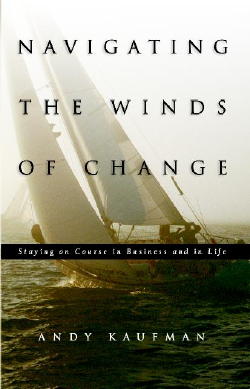
A leadership development resource
from the Institute for Leadership Excellence & Development Inc.
Volume II
Number 1
On the Horizon This Issue:
"Do Less!"
Are you satisfied with what you
accomplished last year? Insight on how to make 2003 a great year!
Special Offers from the
Institute
Learn how to be more comfortable with
ambiguity, and lead change at work
Interview with an Expert: Dr. Steve Levinson
The co-author of Following Through
shares insights on achieving goals.
Brain Teaser
!Take a break to enjoy this Brain Teaser in the Fun section!
[Do Less!] [Special Offers] [Interview] [Fun] [I LEAD Online]
![]()
Welcome to this edition of
Horizon Time!-
Sure last year was busy. But was it busy doing things that are most meaningful to you? The lead article this month shows how you can get past New Year's Resolutions to get actual results this year!
-
 Any
change going on in your life? Would you like to be more comfortable living
and working in ambiguity? Zurich Press just released my new book
Navigating the Winds of Change: Staying on Course
in Business & in Life. Click on the book cover
on the right to get your copy.
Any
change going on in your life? Would you like to be more comfortable living
and working in ambiguity? Zurich Press just released my new book
Navigating the Winds of Change: Staying on Course
in Business & in Life. Click on the book cover
on the right to get your copy. -
It turns out we're wired up to fail at New Year's Resolutions! Check out this edition's Interview with an Expert where Dr. Steve Levinson helps us understand the keys to following through on our intentions.
-
Finally, check out this month's Brain Teaser in the Fun Stuff section!
Can you think of a colleague or friend that is serious about improving their leadership skills? How about forwarding this copy to them? They will join the more than 4,500 subscribers from all over the world who read each edition of Horizon Time.
Thank you for the opportunity to pour into your personal and professional life. God bless you,
Andy Kaufman
Speaker, Author, Consultant
President, Institute for Leadership Excellence & Development Inc.

Learn how to handle change more
effectively. Lead change at work that sticks.. Click on the cover above for
details.
Make this the year you get a handle on your e-mail. Click on the cover to get my new e-book on reducing e-mail clutter.
"Do Less!"
By Andy Kaufman
"My theme for this year is Do Less!"
 Those words from the training director of a prestigious Chicago company
met approving nods from a roomful of peers. Like her, they had just spent
the last year running a pace that was not sustainable.
Those words from the training director of a prestigious Chicago company
met approving nods from a roomful of peers. Like her, they had just spent
the last year running a pace that was not sustainable.
Do less. How does that sound to you?
It doesn't sound like a theme aspiring leaders should be claiming. Yet it resonates with many who look back at the last year and wonder, "When it comes to things that really matter to me, what did I really get done?"
Want to make this year different? The answer is not a fresh boat load of New Year's resolutions. So what is the answer?
Beyond Resolutions
Learning how to take intentions and put them into action is the key.
Getting Results
Want to make this year different? Here are the four steps to turn an intention into reality this year.
1. Pick a compelling intention

Pick one.
Action: Grab a piece of paper and something to write with. Here are some questions to help you make your selection:
-
What are you really dissatisfied with?
Which of those do you have a fair amount of control over?
Which of those would be most satisfying if you nailed it this year?
Now look at your list and find the ones you scored highest on in control and satisfaction. How many do you pick?
That's right! One!
2. Define success.
Define what success looks like. This helps you know when to celebrate. It also helps get your arms around how realistic the intention is.
Perhaps you've heard the acronym
SMART:Specific, Measurable, Action-oriented, Realistic, Time-framed.
"Lose 10 pounds by the end of October" is clearly
SMARTer than "Lose weight".Once you write your
SMART definition of success, take some time to answer these questions:-
If I achieved this, what would be the positive results
How should I celebrate when I achieve this
Write your answers down to these questions. On the days when you might struggle with your intention, look back at these. It will help.
3. Chart a course
"Define success" is about plotting a destination. "Chart a course" is about how to get there.
I work with countless senior executives, managers, and project managers who are hopelessly optimistic, always planning for best case scenarios. Many plans are simply fantasy.
Chart a realistic course. As with shifting winds for a sailor, changes will come along that will require you to make adjustments, but keep on a course that helps you get to the destination.
It helps to figure how much progress you can make on a monthly, weekly, or daily basis. For example, if success is "Increase the number of clients I currently have by 25% by end of year," the plan could be:
-
B
 uy C.J. Hayden's book
Get Clients Now!
(click on the cover to the right to actually do it!)
uy C.J. Hayden's book
Get Clients Now!
(click on the cover to the right to actually do it!) - Read a chapter a week
- By no later than March 1, actively implement the plan that gets developed
4. Keep the intention on the radar screen
One of the hardest parts of implementing an intention is to keep it top of mind. Dr. Levinson talks about how the cards are somewhat stacked against us! Our mind just wasn't wired up to remind us to do what we need to do differently when we need to do it!
 Here are some ideas
to help:
Here are some ideas
to help:
-
Tell others
Ask someone to keep you accountable
Put some positive and negative consequences in place to keep on track.
Sign-up for a goal tracking service
Make it a Great Year
To your success,
P.S. Make sure to check out the
MotivAider® to help you achieve your goals. Click here to learn more.
Special Offers from the Institute
Navigating the Winds of Change: Staying on Course in Business & in Life
Available Now!
"Learning how to effectively manage change is one of the fundamental skills we must develop to be excellent leaders"
Andy Kaufman, author of Navigating the Winds of Change: Staying on Course in Business & in Life
Click here to get your copy from our secure, online bookstore.
Buy a paper copy and download the e-book for free!
Makes a great gift to friends, colleagues, members of your staff, and customers.
Carolyn B. Thompson hits another home run with this insightful look at leadership. Practical, engaging, easy-to-read. Click on the cover to get your copy now!
Interview with an Expert: Dr. Steve Levinson
|
Steve is a fellow speaker and consultant, and a real pleasure to work with. Steve and I caught up with each other in early January. |
| AK: It's that time of year when so many of us venture to craft New Year's resolutions. Despite the best of intentions, many of those resolutions don't make it past the end of January. What is behind this desire to draft resolutions and why is it that we struggle to keep them? SL: We make New Year’s resolutions because, as humans, we have a gift for being able to picture ourselves being better - and better off - than we currently are. Those appealing pictures, of course, motivate us to reach higher. But we also make New Year’s resolutions because we recognize that our good intentions have failed us; that we haven’t been doing a very good job all year long of actually doing what we set out to do, day-in, day-out, to achieve our goals. So a New Year’s resolution is kind of a “Hey, listen up, buster - this time I’m really serious” commitment to do what we’ve intended to do all along. Unfortunately, New Year’s resolutions rarely work any better than everyday intentions. (A comedian once offered a toast that captured the sad truth about resolutions: “May all your troubles last as long as your New Year’s resolutions!”) No matter how sincerely we make them, no matter how delicious we expect the results to be, no matter how excited and committed we feel, the vast majority of our New Year’s resolutions fizzle out rather quickly. Why do we struggle to keep the promises we make to ourselves? And why do we so often lose the struggle? Well, I’ve spent much of my thirty years as a psychologist trying to answer these questions. What I discovered is that the reason we fail to keep so many of the promises we make to ourselves is that the human mind isn’t really designed for follow through. You see, although the mind enables us to do fantastic job of figuring out what promises we should make to ourselves, the mind is also “wired” in a way that virtually guarantees that we will struggle – and usually fail - when we set out to keep our promises. What I’ve learned is that, in
a very real sense, poor follow through is not our fault as individuals.
It’s our problem as a species. What this means for us as individuals is
that until we fully accept and understand the way we're wired, and
until we deliberately and creatively learn how to work around the
wiring, making a New Year’s resolution will continue to be an awful lot
like buying a lottery ticket. SL: A New Year’s resolution is nothing more than the “special holiday edition” of a good intention. We produce good intentions by the truckload. We make promises to ourselves all the time. We make big promises, little promises, and all kinds of promises in between. And because of our wiring, we break many of the promises we make. But, because we’re blessed with an infinite capacity for wishful thinking, we just keep doing the same thing over and over and over again as if the new promises we make will somehow work better than the ones we broke.
SL: The MotivAider® is a remarkably simple electronic device that looks a pager and serves as kind of a Guardian Angel for your good intentions. It’s been in use for the past fifteen years in the healthcare, education/training, business and sports industries worldwide. I invented the device to capitalize on a discovery I made about how the mind treats good intentions. Good intentions only work when they’re at the top of your mind, that is, when you’re actively aware of what you’ve decided you should do and why it’s important to do it. For example, if you intend to improve your posture, you won’t straighten up unless you think about doing it. The problem is, the mind is designed in a way that causes your good intentions to routinely slip out of awareness. The old notion that “If it’s important enough, you’ll remember it,” just isn’t true. The MotivAider® is designed to make good intentions more effective by making sure that you remain actively aware of them. It works automatically and privately to keep your attention sharply focused on any good intention you select. The way the MotivAider® would help you improve your posture, for example, is by automatically sending you a brief, private signal – the entire device, which is clipped to your belt or waistband or carried in a pocket, gently vibrates every few minutes. The signal would mean to you, “Straighten up” or “I’m no slouch.” The MotivAider's self-repeating reminder is guaranteed to prevent your good intention from getting lost in the shuffle. And because (1) the signal can mean whatever you want it to mean, and (2) you can program the device to send you signals as often as you want, you can use the MotivAider® to make sure that virtually any good intention you choose will get the attention it needs to be as effective as possible. AK: Since this
newsletter is read by people who are committed to personal SL: The most important thing we can do is face the truth: The mind works the way it works, NOT the way we think it SHOULD work. It doesn’t work logically. Just because you’ve decided that a goal is important to you and you’re excited about the benefits of achieving it, that doesn’t mean that you will automatically stay motivated to do the things you must do, day-in, day-out, in order to achieve that goal. You have to creatively set things up so that circumstances will keep pushing, pulling, prodding, kicking, or tricking you – whatever it takes – into doing what you need to do. In light of the way the mind is designed, you can’t afford to rely on the “right” reasons to keep you motivated to do the “right” things. You have to boost your motivational horsepower and keep it up there by using “compelling reasons.” For example, if you’re a salesperson, knowing that you can improve your income substantially by starting to make at least ten cold calls a week may be enough to motivate you to promise that you’ll start, but it probably won’t be enough to get you to continue. To continue, you’ll need a truly compelling reason like the one that Jeff created for himself. Every week, Jeff gave his office assistant ten, ten dollar bills to keep in her desk drawer. Every time Jeff made a cold call, he let his assistant know, and she gave him one of his ten dollar bills back. At the end of the week, if there were any tens left, she had strict orders to summon Jeff to her desk and feed the remaining tens to the shredder. Ouch! The point of the story is that the “right” reason for making the dreaded calls didn’t work. The compelling reason, however, worked like a charm. AK: Are you drafting resolutions this New Year? If so, would you be willing to share a couple? SL: I haven’t made any resolutions for 2003, and I can assure you that it’s not because I’ve already achieved perfection! One of things I’ve learned as a result of my work with good intentions is that we break too many promises because we make too many promises. We treat good intentions as if they’re a dime a dozen, and, as a result, that’s about what they’re worth. I’ve become extremely cautious about adopting intentions. Knowing what it will really take to keep a good intention alive makes me very selective about the intentions I adopt. So I now make fewer promises to myself, but I do a much better job of keeping the ones I do make. By the way, if I had made a resolution for 2003, not only would I be willing to share it, I’d jump at the opportunity. Why? Imagine the boost in motivational horsepower I’d get from putting my reputation on the line with your readers. Talk about compelling reasons to follow through!
You can learn more about Steve at www.habitchange.com, Click on the cover to the right to purchase Following Through. |
Recommended Services
Below are some companies whose
services I recommend for your consideration.
There's no reason to pay more than 3.9 cents per minute 24x7 between states in the U.S. Great rates outside the country. I switched over to these guys a couple months ago and have been very happy. Click on the image above to learn more for your work or home!
Fun Stuff
Here is this month's brain teaser, courtesy of Braingle.com:
|
Great King
Five hundred begins it, five hundred ends it, Five in the middle is seen; First of all letters, the first of all figures, Take up their stations between. Join all together, and then you will bring Before you the name of an eminent king. Click here to see the answer. |
Stay in Touch!
Horizon Time is written by Andy Kaufman and is available via e-mail or on the Web for free to all registered subscribers. You are invited to forward this newsletter to anyone interested in growing their leadership skills!
If you have any difficulty with the hyperlinks in this newsletter, you can view it online at:
www.i-leadonline.com/newsletter/0301.htm.
You can access past issues of Horizon Time by visiting www.i-leadonline.com/NewsletterIndex.asp.
If this newsletter was forwarded to you by a colleague and you would like to automatically receive a copy each month, you can subscribe by clicking here. You can unsubscribe by clicking here.
For more information on Andy Kaufman and the Institute for Leadership Excellence & Development Inc., please visit our web site.
You can contact Andy by phone toll-free at (866) 88 I-LEAD (866-884-5323), or by e-mail at andy@i-leadonline.com.
Editors and Newsletter Writers! Would you like to use some of the
material from this newsletter in your newspaper, magazine, newsletter?
You may by including the following credit line:
"This article is used by permission from Andy Kaufman's free monthly
newsletter 'Horizon Time' available at www.i-leadonline.com."
Please call or send an e-mail to let
us know you used the article.
This information cannot be used for resale in any manner.
Horizon Time contains hyperlinks to web sites operated by persons other than the Institute for Leadership Excellence & Development Inc. (I LEAD). Such hyperlinks are provided for your reference and convenience only, and I LEAD is not responsible for the content or operation of such web sites. A hyperlink from Horizon Time to another web site does not imply or mean that I LEAD endorses the content on that web site or the operator or operations of that site. You are solely responsible for determining the extent to which you may use any content at any other web sites to which you might link from Horizon Time.
Copyright © 2003, Institute for Leadership Excellence & Development Inc. (I
LEAD)
![]()





 Steve
Levinson, Ph.D., is a practicing clinical psychologist, inventor,
author and teacher who has devoted much of his career to helping
individuals and organizations follow through on their good intentions.
Steve
Levinson, Ph.D., is a practicing clinical psychologist, inventor,
author and teacher who has devoted much of his career to helping
individuals and organizations follow through on their good intentions. 
